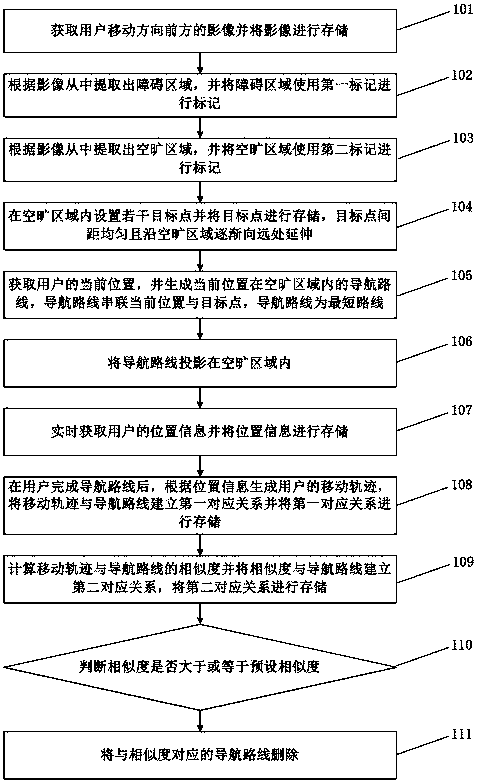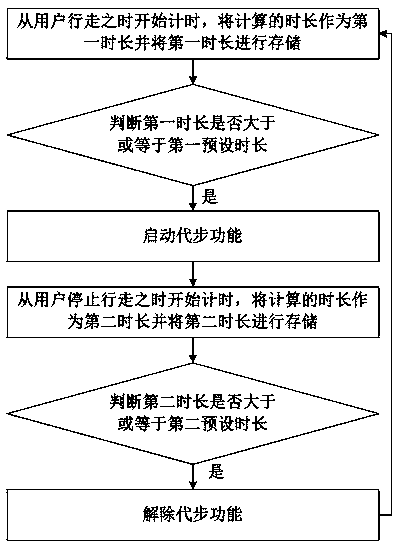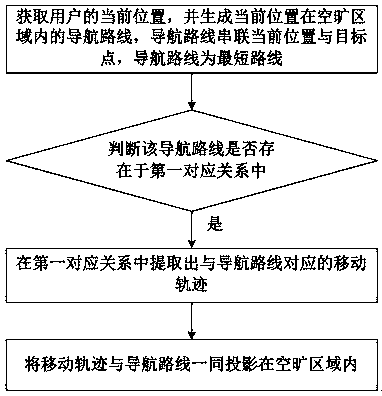A method and system for intelligent learning to walk based on deep learning
A deep learning and intelligent technology, applied in the field of Internet education, can solve the problems of insufficient leg strength of children, danger of children with obstacles, and affecting the health of parents.
- Summary
- Abstract
- Description
- Claims
- Application Information
AI Technical Summary
Problems solved by technology
Method used
Image
Examples
Embodiment 1
[0063] Such as figure 1 As shown, a method of intelligent walking learning based on deep learning includes the following steps:
[0064] 101: Obtain an image ahead of the user's moving direction and store the image;
[0065] 102: Extract the obstacle area from the image, and mark the obstacle area with the first marker;
[0066] 103: Extract an open area from the image, and mark the open area with a second marker;
[0067] 104: Set several target points in the open area and store the target points, the target points are evenly spaced and gradually extend to the distance along the open area;
[0068] 105: Obtain the current location of the user, and generate a navigation route where the current location is in an open area. The navigation route connects the current location and the target point in series, and the navigation route is the shortest route;
[0069] 106: Projecting the navigation route in an open area;
[0070] 107: Obtain the location information of the user in ...
Embodiment 2
[0099] Obtaining the user's current location and generating a navigation route for the current location in an open area also includes;
[0100] The navigation route includes several branch lines, which respectively connect the user's current location with the target point and two adjacent target points, establish a third corresponding relationship between the branch line and the two connected position points and store the third corresponding relationship, the position point Including current position and target point.
[0101] Such as Figure 5 As shown, projecting the navigation route in the open area also includes:
[0102] Extract a target point closest to the user's current location;
[0103] Extract the first branch line corresponding to the target point and the current position;
[0104] Project the first branch line in the open area.
[0105] Such as Figure 6 As shown in , the distance between the user and the target point in the first branch line is calculated in...
Embodiment 3
[0112] Such as Figure 7 As shown, obtaining the user's location information in real time and storing the location information also includes:
[0113] Extract the user's real-time location information and the obstacle area around the location information;
[0114] Calculate the shortest distance between the location information and the obstacle area;
[0115] Determine whether the shortest distance is less than or equal to the preset distance;
[0116] If so, lock the user to stay at the location information;
[0117] Unlock the user when the user tends to move in other directions.
[0118] Such as Figure 8 As shown, when the shortest distance is less than or equal to the preset distance, it also includes:
[0119] Get obstacles in the obstacle area;
[0120] Calculate the hazard level of the obstacle;
[0121] Extract the warning information corresponding to the danger level;
[0122] Output warning messages to the user.
[0123] Specifically, in the process of free...
PUM
 Login to View More
Login to View More Abstract
Description
Claims
Application Information
 Login to View More
Login to View More - R&D
- Intellectual Property
- Life Sciences
- Materials
- Tech Scout
- Unparalleled Data Quality
- Higher Quality Content
- 60% Fewer Hallucinations
Browse by: Latest US Patents, China's latest patents, Technical Efficacy Thesaurus, Application Domain, Technology Topic, Popular Technical Reports.
© 2025 PatSnap. All rights reserved.Legal|Privacy policy|Modern Slavery Act Transparency Statement|Sitemap|About US| Contact US: help@patsnap.com



